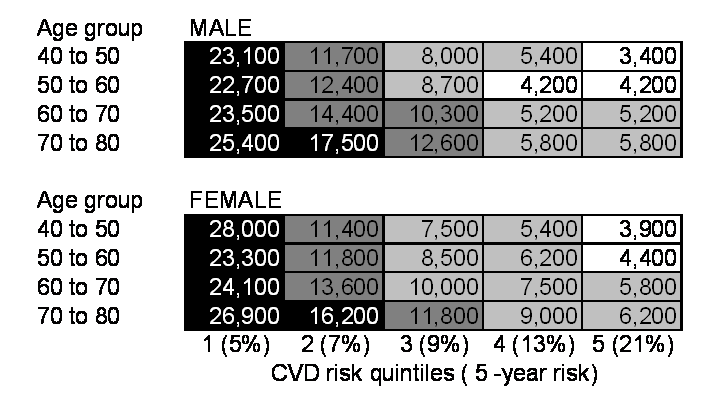Andrew Briggs, DPhil1, Borislava Mihaylova, MSc
2, Mark Sculpher, PhD
3, Alistair Hall, MD
4, Jaap Deckers, MD
5, Maarten Simoons, MD
5, and Kim Fox, MD
6. (1) University of Glasgow, Glasgow, United Kingdom, (2) University of Oxford, Oxford, United Kingdom, (3) University of York, York, United Kingdom, (4) University of Leeds, Leeds, United Kingdom, (5) Erasmus University, Rotterdam, Netherlands, (6) Royal Brompton Hospital, London, United Kingdom
Objective To explore methods of presenting cost-effectiveness information by baseline risk of disease.
Methods An economic model of the ACE inhibitor perindopril based on data from the EUropean trial on Reduction Of cardiac events with Perindopril in stable coronary Artery disease (EUROPA) was developed. Cost-effectiveness is presented as a function of the baseline risk of a primary event (non-fatal myocardial infarction, cardiac arrest or cardiovascular death) in order to identify individuals for whom treatment offers greatest value for money. While the presentation of cost-effectiveness solely on the basis of a clinical risk equation can provide useful information, it is important to also account for the impact of age and sex in the cost-per-QALY calculations. We therefore propose a variation on standard cardiovascular risk tables for presenting cost-effectiveness information by risk while adjusting for age and sex.
Results The median incremental cost per QALY gained from perindopril across the heterogeneous population of EUROPA was estimated as £9,500 (95% CI: £4,800 - £27, 600) with a 25th percentile of £6,500 (£2,000 - £12,300) and a 75th percentile of £14,400 (£6,800 - £41,600). Cost-effectiveness was strongly related to higher risk of a primary event under standard care, but was also related to age and sex, as is shown in the risk tables below.
Conclusions Standard clinical risk equations are an important tool for clinical decision making. However, although cost-effectiveness results are strongly correlated with clinical risk, age and sex can also have an important impact on the cost-per-QALY calculus. Presenting cost-effectiveness tables by risk, age and sex, has the potential to disentangle these important effects and lead to improved decision making.

See more of Poster Session II
See more of The 27th Annual Meeting of the Society for Medical Decision Making (October 21-24, 2005)

